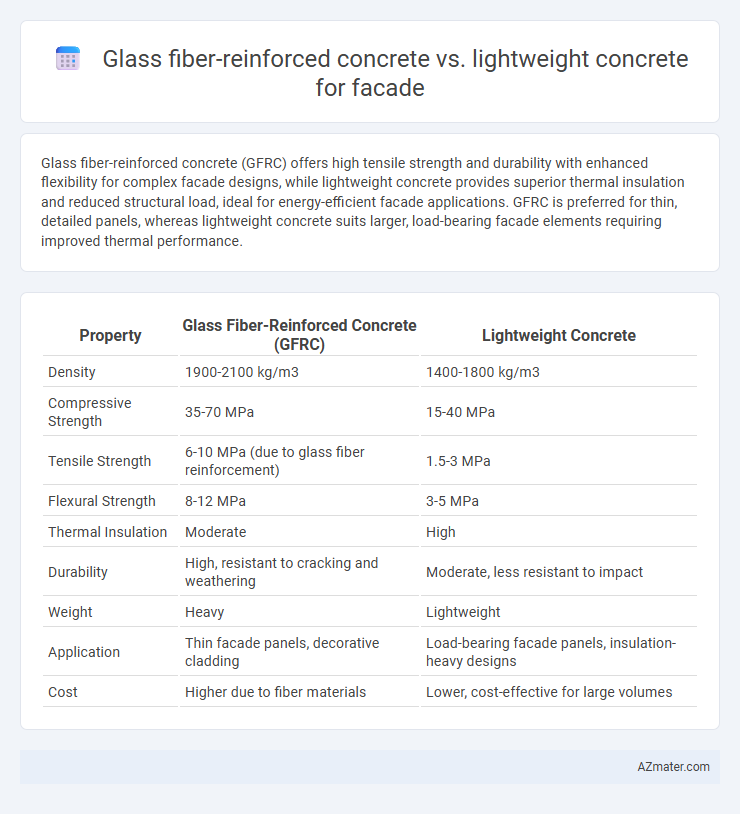Glass fiber-reinforced concrete (GFRC) offers high tensile strength and durability with enhanced flexibility for complex facade designs, while lightweight concrete provides superior thermal insulation and reduced structural load, ideal for energy-efficient facade applications. GFRC is preferred for thin, detailed panels, whereas lightweight concrete suits larger, load-bearing facade elements requiring improved thermal performance.
Table of Comparison
| Property | Glass Fiber-Reinforced Concrete (GFRC) | Lightweight Concrete |
|---|---|---|
| Density | 1900-2100 kg/m3 | 1400-1800 kg/m3 |
| Compressive Strength | 35-70 MPa | 15-40 MPa |
| Tensile Strength | 6-10 MPa (due to glass fiber reinforcement) | 1.5-3 MPa |
| Flexural Strength | 8-12 MPa | 3-5 MPa |
| Thermal Insulation | Moderate | High |
| Durability | High, resistant to cracking and weathering | Moderate, less resistant to impact |
| Weight | Heavy | Lightweight |
| Application | Thin facade panels, decorative cladding | Load-bearing facade panels, insulation-heavy designs |
| Cost | Higher due to fiber materials | Lower, cost-effective for large volumes |
Introduction to Facade Materials: Glass Fiber-Reinforced Concrete vs Lightweight Concrete
Glass fiber-reinforced concrete (GFRC) offers superior tensile strength and durability for facades, making it ideal for intricate architectural designs and long-lasting performance. Lightweight concrete provides excellent thermal insulation and reduced structural load, enhancing energy efficiency and ease of installation. Both materials support aesthetic versatility, but GFRC excels in strength and precision, while lightweight concrete prioritizes insulation and weight savings.
Composition and Material Properties
Glass fiber-reinforced concrete (GFRC) consists of a cementitious matrix combined with alkali-resistant glass fibers, enhancing tensile strength, flexibility, and impact resistance, making it ideal for thin, durable facade panels. Lightweight concrete incorporates lightweight aggregates such as expanded clay or shale, resulting in reduced density and improved thermal insulation but lower structural strength compared to GFRC. The superior mechanical properties and durability of GFRC offer better resistance to cracking and weathering, while lightweight concrete excels in energy efficiency and ease of installation for facade applications.
Structural Performance Comparison
Glass fiber-reinforced concrete (GFRC) exhibits superior tensile strength and crack resistance compared to lightweight concrete, making it ideal for complex facade designs requiring enhanced durability and flexibility. GFRC's higher modulus of elasticity and impact resistance contribute to improved structural integrity under dynamic loads, whereas lightweight concrete offers lower density but reduced load-bearing capacity. The choice between GFRC and lightweight concrete for facades depends on balancing structural performance with weight considerations and aesthetic demands.
Weight and Load Implications for Facade Design
Glass fiber-reinforced concrete (GFRC) offers significantly reduced weight compared to traditional lightweight concrete, typically weighing around 115-130 lb/ft3 versus lightweight concrete's 90-115 lb/ft3. The lower mass of GFRC minimizes structural load on supporting frameworks, enabling slimmer facade assemblies and reducing overall building seismic loads. This weight advantage makes GFRC particularly beneficial for tall buildings and retrofit projects where load constraints and structural efficiency are critical considerations in facade design.
Durability and Weather Resistance
Glass fiber-reinforced concrete (GFRC) offers superior durability and weather resistance compared to lightweight concrete, thanks to its enhanced tensile strength and crack resistance under environmental stress. GFRC's resistance to moisture penetration, freeze-thaw cycles, and UV exposure ensures longer facade lifespan with minimal maintenance. Lightweight concrete, though thermally efficient, tends to absorb more water and is more susceptible to surface degradation in harsh weather conditions.
Aesthetic Versatility and Surface Finishes
Glass fiber-reinforced concrete (GFRC) offers superior aesthetic versatility for facades due to its ability to be molded into intricate shapes and detailed textures, allowing for customized surface finishes such as smooth, ribbed, or patterned effects. Lightweight concrete, while providing enhanced thermal insulation and reduced structural load, typically features simpler finishes and less refined surface detailing compared to GFRC, limiting its aesthetic range. The high tensile strength and flexibility of GFRC enable thin, lightweight panels with diverse color options and surface treatments, making it ideal for architecturally expressive facade designs.
Thermal Insulation and Energy Efficiency
Glass fiber-reinforced concrete (GFRC) offers enhanced thermal insulation due to its dense matrix and integration of glass fibers, which reduce thermal bridging and improve energy efficiency in facade applications. Lightweight concrete, characterized by its lower density and porous structure, provides superior thermal insulation by trapping air within its matrix, significantly reducing heat transfer compared to standard concrete. When optimizing facade performance for energy efficiency, lightweight concrete typically outperforms GFRC in insulating properties, while GFRC excels in strength and durability, making material selection dependent on specific thermal and structural requirements.
Installation Processes and Construction Speed
Glass fiber-reinforced concrete (GFRC) offers faster installation processes due to its lightweight panels, which are prefabricated and easily transported to the site, reducing on-site labor and curing time. In contrast, lightweight concrete requires more extensive casting and longer curing periods on-site, which can slow down construction speed. The prefabrication advantage of GFRC not only accelerates facade erection but also minimizes scaffold and formwork requirements compared to lightweight concrete.
Cost Analysis and Lifecycle Considerations
Glass fiber-reinforced concrete (GFRC) offers a cost-effective solution for facades with lower initial material costs and reduced labor expenses due to its lightweight nature and ease of installation compared to traditional lightweight concrete. Lifecycle cost analysis favors GFRC as it exhibits superior durability, resistance to cracking, and minimal maintenance requirements, extending facade lifespan and reducing long-term repair costs. Lightweight concrete, while potentially cheaper upfront, often incurs higher maintenance expenses due to susceptibility to moisture damage and thermal degradation, impacting total cost of ownership over the facade's service life.
Sustainability and Environmental Impact
Glass fiber-reinforced concrete (GFRC) offers enhanced durability and reduced material consumption, lowering the environmental footprint compared to traditional concrete used in lightweight facades. Lightweight concrete improves thermal insulation and reduces building energy use, contributing to sustainability through lower operational emissions. Both materials reduce the overall carbon footprint by enabling thinner, lighter facade systems that demand less structural support and transport energy.

Infographic: Glass fiber-reinforced concrete vs Lightweight concrete for Facade
 azmater.com
azmater.com